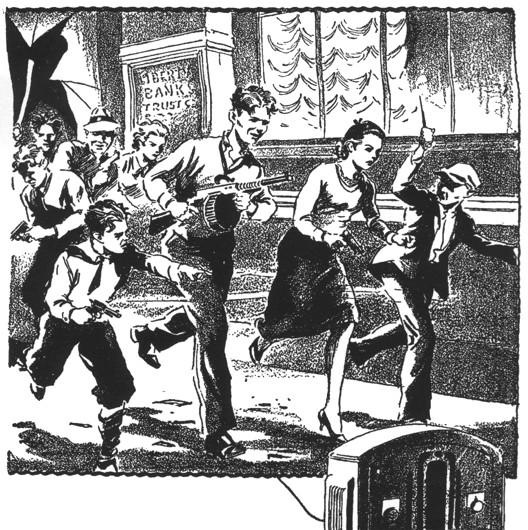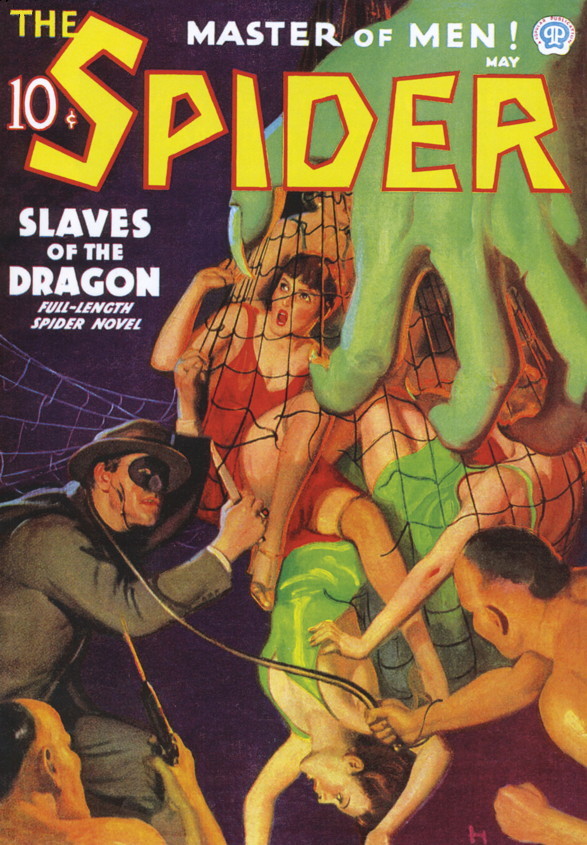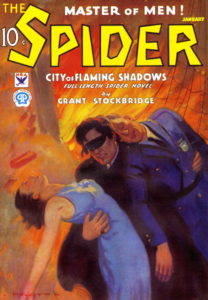
“City of Flaming Shadows” was originally published in the January 1934 issue of The Spider Magazine. Violence fell upon the city, shrouding whole neighborhoods in a brutal gloom — wherein walked screaming death and merciless destruction… Go with The Spider as he battles, single-handedly, to save the very people who pray for his destruction!
This was another fun story from early-on in The Spider’s run of magazine stories. There is no weird-menace type death, here. No living mummies or rabid humans. This is more of a straightforward crime tale. A gang of bank robbers. But, in the usual Spider’s style, this is ramped up to crazy proportions. And so, the peril becomes something that could topple the entire nation. It certainly does make for an enjoyable read.
This was Norvell Page‘s second stab at writing a Spider novel, and he does very well. He still hasn’t reached his stride, yet, but all the basic building blocks are there. The action is non-stop as The Spider reels from one encounter to another. When Richard Wentworth tries to warn the police, he’s either not believed or he’s too late. Nita is not only his beloved, but a very competent aide as well. She, along with Ram Singh and Jenkyns, are the only ones who know of Wentworth’s secret life.
Jackson, Wentworth’s chauffeur, appears here. He was briefly mentioned in the second and third pulp tales, but he actually gets involved in this one. It is specifically mentioned that he does not know his master is The Spider. The story tells us that Wentworth intentionally keeps his servants to a minimum, figuring that the fewer there were, the fewer that could discover his secret. And of them all, only Ram Singh and Jenkyns know that Wentworth was The Spider. Jackson does not know!
An uncomplicated plot
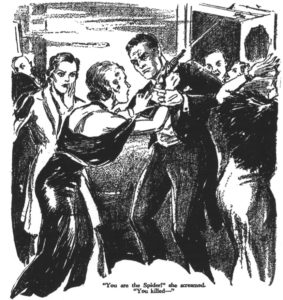
As mentioned above, the plot of this Spider adventure is a pretty uncomplicated one. A gang of bank robbers is looting banks, and it’s up to The Spider to stop them. But wait… there’s more. You see, this gang has learned how to disable the power in the surrounding areas. They have detailed wiring maps of the city, and control the electricity. No lights. And no telephone calls. And no burglar alarms. Now put that together with a bloodthirsty gang that seemingly numbers in the hundreds… a gang that has no compunction about machine-gunning down innocent crowds, and you get a pretty violent story.
As you read this story, you have to put it in perspective. Consider it was written in 1933 and actually hit the newsstands in December 1933 (with an official publication date of January 1934). The Great Depression had struck five years earlier, and the nation was still pulling out of the economic slump. The FDIC (Federal Deposit Insurance Corporation) was just about to be created, but banks were still privately insured against loss. People could… and did… lose their money in banks. Runs on banks were not uncommon.
So, if enough banks were robbed, the insurance companies would go out of business. The individual bank depositors would lose their money. Fear would strike patrons of other banks. There would be a mass withdrawal of funds, more than the banks could withstand. Panic would strike the financial world. The entire nation could topple! Yes, that’s what is threatened in this Spider story. When the gang strikes again and again, it threatens a snowball effect that endangers the whole country.
And only The Spider can stand in their way!
And we open with a bank robbery
Our story opens right after the gang has robbed their first bank in the small upstate town of Hamlettown. It’s their trial run. Richard Wentworth tracks down an inside man, named Reardon. He worked for the electric company as a lineman, and had access to the confidential wiring maps of the city. The robbery gang paid him off to cut the power, and they successfully made off with all the bank’s loot.
Wentworth takes pity on the man; he only got involved because of his sick son. Leaving, Wentworth is attacked by Wiggard, one of the gang, and is cut on the back of his left hand. Unfortunately, the gang has no such pity. For talking with Wentworth, Reardon dies!
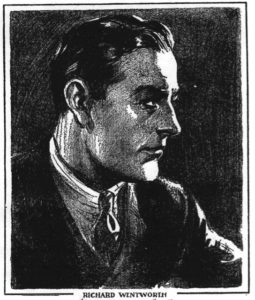
The head of the bank robbery gang is a mysterious character in black hood who calls himself the Tarantula. And now the Tarantula is out to conquer Manhattan. he has a detailed map of Manhattan island, showing in detail every main wire in the city; where every connection is made; every burglar alarm, every telephone connection, every main feed wire; every tunnel through which these go beneath the streets.
Yes, they are ready. The gang first strikes at Earl Carroll’s Vanities at the New Amsterdam Theater. They take jewels from women in the lobby and take the money in the box office. All to help finance their further ventures. Luckily, Richard Wentworth is in attendance.
The lights go out. Wentworth and Nita van Sloan are attacked. The robbers make off with the jewels and cash, but Wentworth is on their trail. There are car chases… machine-gun fire… dead bodies galore… and after some furious action, Nita van Sloan is kidnapped.
The Tarantula!
The Tarantula is responsible. If Wentworth calls the police, Nita will be hanged in a most grisly fashion. Wentworth is given instructions. He is to book passage on the ocean liner Europa leaving day after tomorrow. Once Wentworth is in Europe, one of the Tarantula’s agents will tell him what to do. When he reaches London, he will determine the best way to obtain maps of its wiring system. The Spider is being forced to assist the Tarantula. Nita will talk over the phone to him every day to assure him of her safety. But at the first sign of disobedience, she dies.
Wentworth figures out a way to stay in New York and send an impostor to England in his place. He says in the city in the guise of Inspector Rupert Barton of Scotland Yard. But things still go from bad to worse. Thirty people are killed in the next bank robbery. There are suspicious people galore, all of whom could be the mysterious Tarantula. Police Commissioner Stanley Kirkpatrick is abducted, leaving Deputy Commissioner Shane Penrose in his place. And Penrose is about the stupidest, most contrary, hard-headed individual Wentworth had encountered.
More robberies. More killings. Banks are going out of business. Insurance companies are going broke. There is a run on every bank still in business in the town. Depositors are rioting outside closed banks. The Governor is prepared to put the city under martial law. President Roosevelt closes every bank in the city.
Of course, in the end, all is resolved and the nation is once again safe. And all thanks to The Spider. Whew, what a story!

Those clever little touches
There are some neat little items that add some nice touches to the story. One interesting trick is that our chief baddie, the Tarantula, takes the skin from a corpse’s hands and tans them like leather. Then he uses them like gloves to disguise his appearance. Gross? Yes. But effective? You bet!
Readers are given a little past history on Inspector Barton. Scotland Yard valued his services in the past so much that they had given Wentworth the fictitious title of Inspector Barton and had promised not to give out any information about him to anyone including police of the world. This has saved him before, we are told, referring to some undocumented previous adventure.
So, why is The Spider called the Master of Men? This pulp adventure explains. There is something in his sharp commanding tone that gets obedience. There was a compelling power about the man, a vital force that men of action recognized. He was a leader; when he chose to lead, others followed readily.
Faithful reader of The Spider know he carries a toolkit under his arm. In this adventure, we are told that it contains two small vials. He pours their contents into a slit at the top of a steel door and lights it with a match. The blast, a terrific detonation, twists the metal door. Now that’s one way to get through a sealed door! He uses it twice in this story.
Shane Penrose, Deputy Commissioner of Police, only appeared in this one Spider story. Readers are told that he has a long-running private feud with The Spider. Actually, though, this was his first appearance in the magazine series, and the feud was never referred to in earlier stories. And the end of the story, it is casually mentioned in passing that Penrose has died in the final battle, so he never appears in future tales.
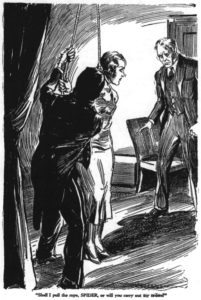
And a few plot holes
There were a few nagging plot holes that I noticed. In one scene, Wentworth is struck unconscious by the hilt of a thrown knife. It luckily saves him from a confrontation with Commissioner Kirkpatrick, where he was being framed for a murder. Later we find out it was Ram Singh who threw that knife, at Wentworth’s instructions. But how did Wentworth know in advance to give those instructions? He had no way of knowing who he would follow, or where they would take him, or that he could encounter Kirkpatrick or that Kirkpatrick would acquire evidence that would implicate him. And yet he instructed Ram Singh in advance to throw the knife and knock him out. Hmmm… just one more instance of the suspension of disbelief, I guess.
In another unexplained curiosity, Wentworth tracks the kidnapped Nita to a sealed room. He can’t find the door, so finally hacks through a wall with an axe, and squeezes through the tiny opening. As soon as she is freed, Penrose shows up, holding a gun on him. How did Penrose get in the room? If Wentworth couldn’t find the door, certainly the stupid Penrose couldn’t, either. And he certainly couldn’t fit his large form through that small hacked hole in the wall. So how did he get in? We may never know…
I’ve also wondered about Wentworth’s police card. It’s been mentioned in several different stories. Apparently this is some sort of card that gives him some standing with the police. Some honorary thing. But I’ve always wondered how Wentworth got one. He has a contentious standing with police. They constantly suspect him of being a mass murderer. Why would they give him a police card. It doesn’t make sense to me.
So, this title… “City of Flaming Shadows”… what what that all about? Well, I guess you weren’t suppose to take it literally. When the gang strikes, the lights go out, and you have… shadows. And the “flaming” part? Well, there’s a lot of killing and violence during those raids. So if you want a straightforward title, it would more closely translate to “City of Violent Darkness.” But somehow, that doesn’t sound as exciting, does it?
And, exciting this story is! Bank robberies don’t generally sound like the basis for a thrill-a-minute tale suitable for The Spider, but it turns out that it actually does quite nicely. I like it, and I think you will too!

